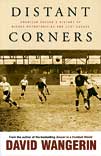 American Soccer's History of Missed Opportunities and Lost Causes
American Soccer's History of Missed Opportunities and Lost Causes
by David Wangerin
Temple University, £19.99
Reviewed by Ian Plenderleith
From WSC 296 October 2011
Long is the history of failed football ventures in the US, and short is the list of writers who have been prepared to document them for the benefit of a doubtless unsuspecting world. In this follow-up to his excellent history of US football, the WSC-published Soccer In A Football World, David Wangerin focuses on a handful of the key characters and eras that were central to some of the game's false dawns in a country whose footballing possibilites have always loomed over the world game like a potential new age. Or potential apocalypse, depending on your view of US hegemony.
Wangerin has a stoical but cheerful approach to US football history, and clearly enjoys unearthing people, games and anecdotes long since confined to the pages of yellowing local newspapers. This comes out well in the opening chapters on early 20th century touring teams from Europe, the birth of the US Open Cup (the second oldest surviving cup competition in the world after the FA Cup) and the possibly visionary but ultimately thwarted administrator Tom Cahill. In 1946 Cahill pronounced: "I've known, everyone in soccer has known, that until there are adequate stadium facilities, the game will never be a financial success." It took another 50 years before MLS came along and realised the same truth.
His chapter on college team Penn State's coach Bill Jeffrey also treads previously uncovered territory, including fascinating stories of tours to Scotland in the 1930s and Iran in 1951. From there it is on to the leagues and teams of St Louis, the US city most likely to boast the cliche of "footballing hotbed", and Wangerin rattles off numerous tales of pre-war foul play, crowd violence, player-poaching, widespread flaunting of rules and shameless intimidation of referees. The city also hosted a team with one of the best names ever, the St Louis Screw.
The final two chapters, however, really make this book sing. Prior to the modern era, research necessarily relies on dry documentation, while the fragmented, stop-start nature of the early US game makes a strong narrative arc difficult. This all changes come the late 1960s and teams like Oakland's California Clippers, a briefly successful NASL club founded by businessmen looking to cash in on football, and made up almost entirely of Yugoslavs and Costa Ricans. Their story has a beginning, middle and end, and many of the people who were there are still around to tell the tale.
The last chapter, Shot Out In Jersey, covers the New York Cosmos, and this is my only quibble with this book. The first five chapters were interesting enough, and should be read by all US fans scrambling for a sense of tradition. The final two chapters, though, left me wanting more. The flops, failures, flukes and flashes of the bust-boom-bust NASL are a largely unmined treasure of football stories, and many of its protagonists must be at just the right age to talk about it with the necessary perspective. If we're in luck, it's a project-in-waiting for the fluid, meticulous Wangerin.